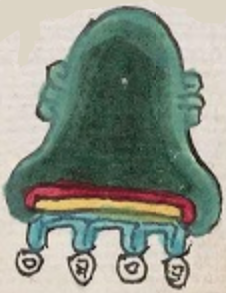Ixicayan (Mdz40r)
This compound glyph for the place name Ixicayan (perhaps "Natural Spring," or literally "Where Leaking is Constant") has two main elements, a green, bell-shaped hill or mountain (not part of the name, unless it serves as a type of locative) and some turquoise-blue water leaking out of the base of the mountain, emerging from its red and yellow interior access point.
Stephanie Wood
This is a visual for the verb, ixica, to leak. The water, with its lines of current and turbinate shells and droplets (which some people interpret to be chalchihuites, or local jade stones) emerges from the site of the horizontal red and yellow lines that suggest the location for a mountain spring. Together, water (atl) and mountain (tepetl) form the word altepetl, which means town or a socio-political unit. This has the potential to be applicable in any number of representations for place names, as a visual and silent locative in the form of a tepetl can be serving as what Whittaker would call a "semantic complement." These same yellow and red lines also appear where water emerges from the top of an arm, at the shoulder (acolli), in the compound glyph for Acolhuacan (see below, right).
The locative suffix -yan is one that attaches to verbs and indicates customary action, as pointed out by Frances Karttunen (unpublished manuscript, used here with her permission.) So, this would be a place where the leaking occurs regularly, and therefore, again, it is likely the site of a natural spring.
Stephanie Wood
yxicayā. puo
Ixicayan, pueblo
Stephanie Wood
c. 1541, or by 1553 at the latest
Stephanie Wood
water, mountains, hills, shells, agua, montañas, cerros, caracoles, conchas, manantiales, Yxicayan, nombres de lugares

ixica, to leak, https://nahuatl.wired-humanities.org/content/ixica
-yan (locative suffix), where things are done habitually, https://nahuatl.wired-humanities.org/content/yan
a(tl), water, https://nahuatl.wired-humanities.org/content/atl
"Place Where Water Seeps Out" (Berdan and Anawalt, 1992, vol. 1, p. 230)
Codex Mendoza, folio 40 recto, https://digital.bodleian.ox.ac.uk/objects/2fea788e-2aa2-4f08-b6d9-648c00..., image 90 of 188.
The Bodleian Libraries, University of Oxford, hold the original manuscript, the MS. Arch. Selden. A. 1. This image is published here under the UK Creative Commons, “Attribution-NonCommercial-ShareAlike 3.0 License” (CC-BY-NC-SA 3.0).







